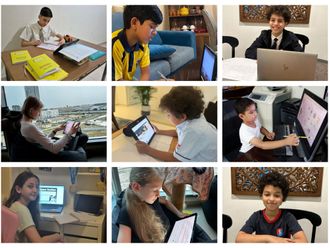
There’s no doubt that every parent based in the UAE has been faced with the task of choosing the right school for their child. From sifting through Knowledge and Human Development Authority (KHDA) ratings to picking the most convenient location, not to mention the endless waiting lists and working out whether or not it will be affordable.
There’s also the matter of choosing the right curriculum. Children based in their home countries grow up through the same schooling system as everyone else, but owing to the cosmopolitan nature of the UAE, there are about 16 curricula to choose from, including American, British, Indian, and even Japanese.
The best options
So how do you make the right choice? The key, it seems, is looking to the future. “The factors will greatly depend on what objectives you have for your child,” explains Nafez Dakkak, a UAE-based education consultant. “For example, if you would like them to study abroad, it will be best to opt for an internationally-recognised curriculum, such as the International Baccalaureate (IB) or the curriculum of the country they plan to study in.
“Additionally, it will be determined by the aspirations of parents for their children with regards to extracurricular activities and producing well-rounded children.”
Clive Pierrepont, director of communications and marketing at Taaleem agrees: “The most important feature is that the curriculum is skill-based, student-centred and designed to foster awareness, attitudes and international mindedness.”
What about curriculum versus nationality? There are currently 153 private schools in Dubai, and according to a 2013 report by the KHDA, more than 88 per cent of all students in Dubai (precisely 225,099 students) attend private school. The most popular curriculum is the UK National Curriculum (31.5 per cent of the total students in Dubai), closely followed by Indian (30 per cent), and then American (21.2 per cent). It is also a common misconception that you should choose a curriculum based on your own nationality. “Gone are the days when there was just one curriculum in one country,” says Pierrepont. “In the UK all universities accept internationally-accredited examinations whether they are the IB, American High School Diploma or A-levels.”
Regardless of the curriculum you choose, you needn’t worry about the types of universities that will be available later on for your child. “IB offers you as many opportunities as any of the other curricula,” Dakkak says. “Additionally, most British or American top-tier institutions allow you to count advanced IB studies towards university credit.”
Pierrepont adds: “The IB diploma has certainly gained a reputation as being the gold standard of pre-university qualifications. Its distinguishing feature being far more differentiating at the top end and very few pupils achieve the maximum mark of 45 points — in fact, 30 points at IB level has been equated to three A’s at A-level by the Universities and Colleges Admissions Service in the UK.”
But the proof really is in those who completed high school in the UAE. Alina Mezentseva, a Russian PR professional, grew up on three curriculums. “I did British (grades 1 to 4), American (grades 4 and 5) and Russian (grades 6 to 11),” she says. “I think I obtained the best education I could – a diverse one. It was interesting to eventually study in a Russian school, because it allowed me to get back in touch with my roots. I went on to study at the American University in Dubai, which I had absolutely no problems entering as the admissions committee was familiar with the curriculum.”
Another UAE resident is journalist Bindu Rai, whose parents opted for British teaching, while she chose a university in the US. “I was placed in an Indian curriculum during kindergarten, but then Cambridge High School opened its doors (one of the first few schools to offer a British curriculum), and my parents were persuaded to transfer me from Grade 1. It was the best decision,” she says. “Avenues opened up for me not just academically, but also in the arts. Even though I studied British, I went on to attend Southern New Hampshire University — I had no problems with my application.”
Time for change
The most important thing to remember is that once you have made a decision regarding your child’s curriculum is to not to go back and change it. “Transition should be easy for primary and middle school students; good curricula are skills-based and these are always transferable. Transfer becomes more challenging during the latter teenage years when external examinations are being studied for and specific course-related knowledge is required to pass,” explains Pierrepont.
Another factor is the length of time you will spend abroad; the longer your child is out of their country of origin, the more likely it is that they will only be able to attend a university back home as an international student. “If your child has lived outside of the UK, for example, with his/her parents not paying tax, then the child would only be able to attend a British university as an international student,” he continues.
In order to avoid huge fees, it is advisable to consult your child’s school a few years in advance to explore your options. ■













